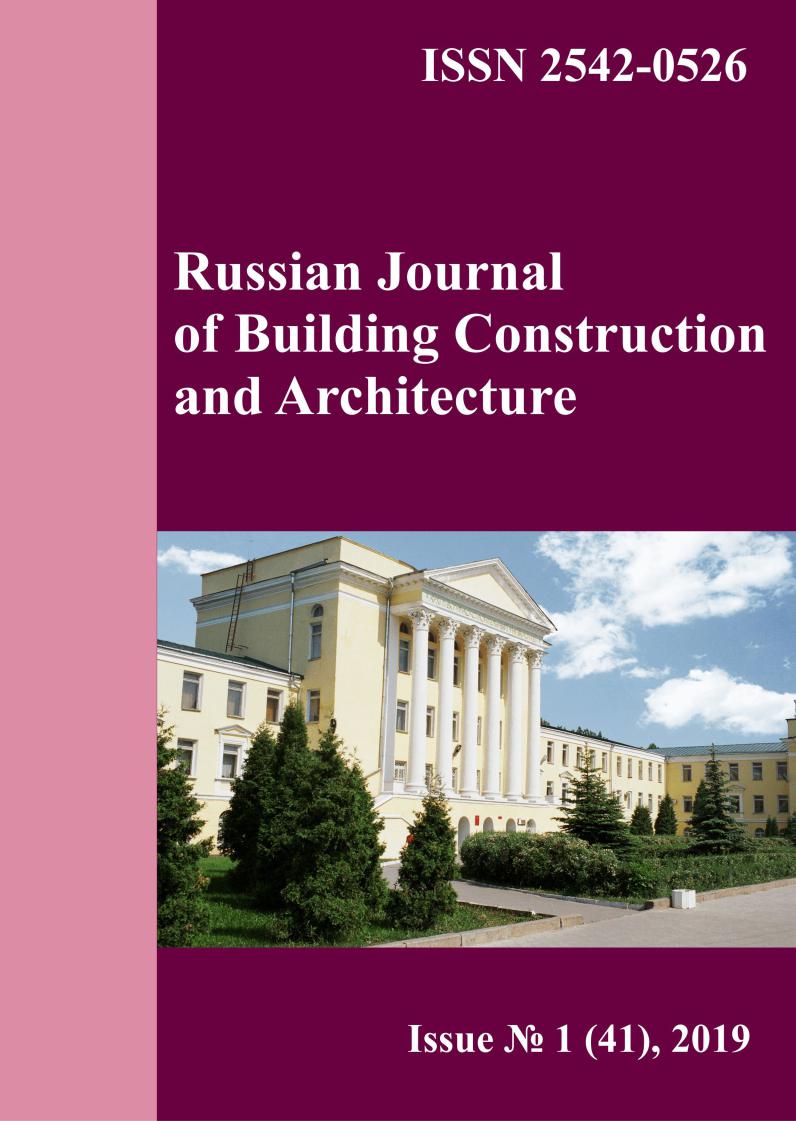
Russian Journal of Building Construction and Architecture
.pdf
RUSSIAN JOURNAL
OF BUILDING
CONSTRUCTION AND ARCHITECTURE
1

The journal is indexed/abstracted in:
Web of Science Core Collection
(Emerging Sources Citation
Index)
(Thomson Reuters), USA
Ulrich's Periodicals Directory
(Bowker), USA,
DOAJ
(Lund University), Sweden,
Academic Search Complete
(EBSCO), USA,
SOCOLAR
(China Educational Publications Import and Export Corporation –– CEPIEC), China,
Google Scholar
(Google), USA,
E-Library
(ООО «РУНЭБ»), Russia,
J-Gate
(Informatics Ltd), India
2
ISSN 2542-0526
RUSSIAN JOURNAL
OF BUILDING
CONSTRUCTION AND ARCHITECTURE
N 1 (41)
BUILDING STRUCTURES, BUILDINGS AND CONSTRUCTIONS
BASES AND FOUNDATIONS, UNDERGROUND STRUCTURES
HEAT AND GAS SUPPLY, VENTILATION, AIR CONDITIONING, GAS SUPPLY AND ILLUMINATION
BUILDING MATERIALS AND PRODUCTS
TECHNOLOGY AND ORGANIZATION OF CONSTRUCTION
DESIGNING AND CONSTRUCTION OF ROADS, SUBWAYS, AIRFIELDS, BRIDGES AND TRANSPORT TUNNELS
BUILDING MECHANICS
THEORY AND HISTORY OF ARCHITECTURE, RESTORATION AND RECONSTRUCTION OF HISTORICAL
AND ARCHITECTURAL HERITAGE
ARCHITECTURE OF BUILDINGS AND STRUCTURES. CREATIVE CONCEPTIONS OF ARCHITECTURAL ACTIVITY
CITY PLANNING, PLANNING OF VILLAGE SETTLEMENTS
FIRE AND INDUSTRIAL SAFETY (CIVIL ENGINEERING)
Voronezh 2019
3

Russian Journal
of Building Construction and Architecture
Periodical scientific edition
Published since 2009 |
Comes out 4 times per annum |
Founder and publisher: Federal State Education Budget Institution of Higher Professional Education «Voronezh State Technical University».
The articles are reviewed and processed with the program ANTIPLAGIARISM. This publication cannot be reprinted without the prior permission of the publisher, references are obligatory.
Number of the certificate of registration of the media ПИ № ФС 77-67855
Issued by the Federal Service for Supervision of Communications, Information Technology, and Mass Media (Roskomnadzor)
Price is subject to change
EDITORIAL COUNCIL
The Head of the Council: Kolodyazhny S. A., D. Sc. in Engineering, rector (Voronezh State Technical University)
EDITORIAL BOARD
Editor-in-Chief: Melkumov V. N., D. Sc. in Engineering, Prof.
(Voronezh State Technical University)
Members:
Boldyrev А.М., Corresponding Member of the Russian Academy of Architecture and Engineering Science, D.Sc. in Engineering, Prof., Voronezh State Technical University, Russia
Bondarev B. А., D. Sc. in Engineering, Prof., Lipetsk State Technical University, Russia
Gagarin V. G., Corresponding Member of RAABS, Moscow State University of Civil Engineering, Russia
Gelfond А. L., Corresponding Member of the Russian Academy of Architecture and Construction Science, D. Sc. in Architecture, Nizhniy Novgorod State University of Architecture and Construction, Russia
Enin A. Ye., PhD in Architecture, Prof., Voronezh State Technical University, Russia
Karpenko N. I., Academician of RAABS, Research Institute of Building Physics (NIISF RAABS), Russia
Kirsanov М.N., D.Sc. in Physics and Mathemat-
ics, Professor (National Research University “Moscow Power Engineering Institute”)
Kobelev N. S., D. Sc. in Engineering, Prof., Southwest State University, Kursk, Russia
Kolchunov V. I., Academician of RAABS, Southwest State University, Kursk, Russia
Ledenyev V. I., D. Sc. in Engineering, Prof., Tambov State Technical University, Russia
Lyahovich L. S., Academician of RAABS, Tomsk State University of Architecture and Building, Russia
Mailyan L. R., D. Sc. in Engineering, Prof., Don State Technical University, Rostov, Russia
Panibratov Yu. P., Academician of RAABS, Saint Petersburg State University of Architecture and Civil Engineering, Russia
PodolskyVl.P.,D. Sc. in Engineering, Prof., Voronezh State Technical University, Russia (Dep. of the Editor-in-Chief)
SlavinskayaG.V.,D. Sc. in Chemistry, Prof, Voronezh State Technical University, Russia
SuleymanovА.М.,D. Sc. in Engineering, Prof., Kazan State University of Architecture and Engineering, Russia
Fyedorov V. S., Academician of RAABS, Moscow State University of Railway Engineering, Russia
Fedosov S. V., Academician of RAABS, Ivanovo State Polytechnic University, Russia
Chernyshov Ye. M., Academician of RAABS, Voronezh State Technical University, Russia
Shapiro D. M., D. Sc. in Engineering, Prof., Voronezh State Technical University, Russia
Shubenkov М. V., Academician of the Russian Academy of Architecture and Construction Science, D. Sc. in Architecture, Prof., Моscow Institute of Architecture (State Academy), Russia Asanowicz Alexander, Prof., Dr. of Sn., Technical University of Bialystok, Poland
Figovsky Oleg L., Prof., Dr. of Sn., Member of EAS, Israel Korsun V. I., D. Sc. in Engineering, Prof., The Donbas National Academy of Civil Engineering and Architecture, Ukraine Nguyen Van Thinh, Prof., Dr. of Sn., Hanoi University of Architecture, Vietnam
Editor: Kotlyarova E. S. |
Translator: Litvinova O. A. |
THE ADDRESS of EDITORIAL AND THE PUBLISHER OFFICE:84 20-letiya Oktyabrya str., Voronezh, 394006, Russian Federation Tel./fax: (473)2-774-006; e-mail: vestnik_vgasu@mail.ru
Publication date 11.02.2019. Format 60×84 1/8. Conventional printed sheets 13.7. Circulation 500 copies. Order 16.
Published in Printing Office of Voronezh State Technical University 84 20-letiya Oktyabrya str., Voronezh, 394006, Russian Federation
ISSN 2542-0526 |
© Voronezh State Technical |
|
University, 2019 |
4
CONTENTS |
|
BASES AND FOUNDATIONS,UNDERGROUND STRUCTURES....................................................... |
7 |
Sedaev A. A. |
|
Presentation of a Kernel and Transformants of a Nonclassical Elastic Foundation Through |
|
its Inhomogeneity Function ............................................................................................ |
7 |
HEAT AND GAS SUPPLY,VENTILATION,AIR CONDITIONING, |
|
GAS SUPPLY AND ILLUMINATION............................................................................................ |
18 |
Astashev S. I., Medvedeva O. N., Chuikin S. V., Sklyarov K. A. |
|
The Optimization of Operating Modes of Technological |
|
Equipment for Underground Gas Storage................................................................................ |
18 |
Gnezdilova O. A. |
|
Automated Registration of Small-Scale Natural Gas Consumption Using |
|
a New Software Product........................................................................................................... |
32 |
Saprykina N. Yu., Panov М. Ya. |
|
Investigation of the Influence of the Modes of the Operation of a Geothermal Well |
|
with the Systems of Heat Supply and Air Conditioning in Combination |
|
with a Thermal Pump on the Temperature of a Soil Layer...................................................... |
38 |
TECHNOLOGY AND ORGANIZATION OF CONSTRUCTION ....................................................... |
51 |
Kukina O. B., Abramenko A. A., Volkov V. V. |
|
Optimizing the Composition Quality of the Non-Firing Limestone-Sand |
|
Phosphogypical Material.......................................................................................................... |
51 |
Semenyuk S. D., Moskal'kova Yu. G. |
|
Calculation Method for the Formation of Microcracks Taking Into Account |
|
the Density of Claydite Concrete............................................................................................. |
59 |
TECHNOLOGY AND ORGANIZATION OF CONSTRUCTION ....................................................... |
68 |
Kopytina E. A., Petrikeeva N. A., Tul'skaya S. G., Kuznetsov S. N. |
|
Application of the Game Theory in Construction Activity...................................................... |
68 |
Zadiraka A. A., Kokodeeva N. Ye., Kochetkov A. V. |
|
Technology for Laying and Strenthening Transportation Facilities Based |
|
on a Polyurethane Composite................................................................................................... |
77 |
5

Tsaplin A. I., Zhalko М. Ye. |
|
Mathematical Analysis of Humidity Ure Transfer of Underground Water in the Subbase |
|
of Road Surfacing and Predicting the Parameters of a Drainage System................................ |
84 |
THEORY AND HISTORY OF ARCHITECTURE,RESTORATION AND RECONSTRUCTION |
|
OF HISTORICAL AND ARCHITECTURAL HERITAGE................................................................ |
91 |
Podolskaya L. V. |
|
“I’ve Come to Say that i Have the Rights”: Russian Modernism in Architecture |
|
and Interior Design –– Reemergence in the 21st Century ........................................................ |
91 |
ARCHITECTURE OF BUILDINGS AND STRUCTURES.CREATIVE CONCEPTIONS |
|
OF ARCHITECTURAL ACTIVITY............................................................................................. |
102 |
Özdamar Esen Gökçe |
|
The Red Narrative Cinema: an Urban Montage in Moscow.................................................. |
102 |
INSTRUCTIONS TO AUTHORS................................................................................................. |
117 |
6

Issue № 1 (41), 2019 |
ISSN 2542-0526 |
BASES AND FOUNDATIONS,UNDERGROUND STRUCTURES
DOI 10.25987/VSTU.2018.41.1.001
UDC 539.3 : 624.073.2
A. A. Sedaev1
PRESENTATION OF A KERNEL AND TRANSFORMANTS
OF A NONCLASSICAL ELASTIC FOUNDATION
THROUGH ITS INHOMOGENEITY FUNCTION
Voronezh State Technical University Russia, Voronezh, e-mail: sed@vmail.ru
1D. Sc. in of Physics and Mathematics, Prof. of the Dept. of Applied Mathematics and Mechanics
Statement of the problem. The paper is devoted to the question of practical applicability of a mathematical model by Aleinikov-Snitko which describes the contact interaction of a subbase and a shallow foundation. The main results of this method were announced with no proof in 2009 in a joint article [3].
Results. In this paper, based on the methods of integration and the Hankel transform, all the formulas and tools of the model by Aleinikov-Snitko are fully proven and optimized. Here we calculate and compare the results obtained by means of this method and the classical Mindlin method based on the theory of elasticity for a foundation whose elastic modulus is given by a power function. Interestingly, the results obtained are similar in form, but differ in magnitude. Using these results, we obtain simple approximate formulas for finding the precipitation of the base surface from the action of a point vertical load for both methods.
Conclusions. The formulas proved in the article can be useful in modeling the interaction of the soil base and the foundation, which is crucial in construction and design.
Keywords: inhomogeneous linearly deformable half-space, influence matrix, base kernel, transformant, base non-uniformity function, quasitransformant, Bessel function, Hankel transform.
Introduction. The problem of mathematical modeling of the interaction of a foundation with a subbase is a quite challenging one and has no universal solutions for all types of soils. The simplest for engineering calculations is the known Winkler model with one foundation coefficient. The main disadvantage of this model is that is fundamentally impossible to reflect a distribution capacity of soil in transmitting a vertical load in a horizontal direction while involving those layers of soil that are beyond the loading area [11, 13].
© Sedaev А. А., 2019
* The work is supported by the Russian Fund for Basic Research, grant № 17-01-00138.
7

Russian Journal of Building Construction and Architecture
Unlike the Winkler model, homogeneous elastic half-space modeling a subbase foundation using the elasticity theory causes an increase in the distribution capacity of actual soil.
In practice in order to mitigate the above disadvantages, the Winkler model is supplemented by new parameters (extra foundation coefficients) and a model of an elastic half-space is assumed to have elastic characteristics (elasticity modulus or the Poisson coefficient) that change as does the depth of a foundation point.
In [1, 3] S. М. Аleynikob following N. K. Snitko’s suggestion [15] developed a calculation scheme for the interaction of a foundation and heterogeneous foundation base. In this paper an analytical aspect of the method is developed and compared with the classical approach based on the methods of the elasticity theory and the Fourier transformation. The problem of identifying the main part of the deposit of the surface of a soil foundation under the effect of a concentrated force is discussed as well as the options for practical implementation of the method.
1. Statement of the problem and preliminary data. A model of a linearly deformed foundation (half space) will be used where settling w and distributed along the area on a daytime surface of a half space and the load q are connected with a ratio
w(x, y) G(x, y,u,v) q(u,v)du dv, |
(1) |
|
|
where G(x y u v) is a so-called nuclear of an elastic foundation [12]. The latter is an influence function that equals the displacement of the pointP(x y) of a daytime surface of an elastic halfspace caused by a single vertical concentrated force applied to the pointQ(u v) of the surface.
Note that for the half-space which is isotropic in a horizontal area when its deformation characteristics depend only on the vertical coordinate z , nuclear G(x, y,u,v) depend only on the distance r between P and Q . It is the case that will be dealt with as we proceed.
1.1. Representation of the influence function based on the methods of the elasticity theory.
Let a single load be concentrated at the beginning of the coordinate system XOY on a daytime
surface and thus r x2 y2 . The use of the methods of the elasticity theory and Fourier transformation lead to the following formula [10, 12, 14] while searching for an influence function:
w(x, y) (r) |
1 |
sc(s)J0(sr)ds, |
(2) |
|
|||
|
2 0 |
|
|
where J0 (x) is the first-class Bessel function of order zero and c(s) |
is a so-called transform |
||
that meets (according to the Fourier transformation) the equation |
|
||
c(s) 2 0 r (r)J0 (sr)dr. |
(3) |
||
8

Issue № 1 (41), 2019 |
ISSN 2542-0526 |
Note that the integrals (2) and (3) included in the formulas are nothing but a direct and reverse
Hankel transformation which for the Bessel function of orderk Jk |
is given by the formula |
Hk ( f )(r) 0 sf (s)Jk (sr)ds. |
(4) |
1.2. Calculation of the nuclear using the function of heterogeneity of a foundation. Following the example of N.K. Snitko [15], S. М. Аleynikov developed an alternative method for identifying the function that determines the nuclear for an isotropic, heterogeneous linearly deformed half-space. Let E(z) be the elasticity modulus of a foundation depending on the depth z, and is the Poisson coefficient of the half-space that will be considered constant. Then according to [1, 3], settling of a daytime surface caused by a single load can be specified with the equation
|
(1 2) |
z3dz |
|
|
|
|
|
2 |
|
2 |
|
|
||
(r) |
2 |
0 |
|
, |
R |
|
r |
|
z |
|
, |
(5) |
||
e(R)R5 |
|
|
|
|||||||||||
where the function |
|
|
|
|
|
|
|
|
|
|
|
|
|
|
e(R) 01 E(Rt)t2dt |
1 |
0R E(z)z2dz |
1 |
|
0R E(z)dz3,R 0 |
(6) |
||||||||
R3 |
3R |
3 |
||||||||||||
is generated by the law of changeE(z) and called the function of heterogeneity of a foundation. For a homogeneous space when E(z) E0 const , the formulas (2) and (5) yield the same results while in other cases (e.g., whenE(z) En zn ) these formulas yield similar-looking but different expressions for (r).
The comparison of the formulas (2) and (5) shows that the functions c(s) and e(R) play a similar role, i.e. they generate a nuclear of an elastic foundation. Certainly there is an issue with identifying a function similar to c(s) that corresponds with a new method. I.e. using the specified function e(R)we will be identifying such a function C(s) so that with the formula (2) it yielded the same result that the formula (5). Such a function C(s) will be called a quasi-transform one.
2. Main results
2.1. Presentation of a quasi-transform using a function of heterogeneity of a foundation.
The first formula is obtained by inserting the expression (5) into the formula (3):
|
|
|
|
|
|
|
|
|
(1 2) |
|
|
z3dz |
|
|
||||
C(s) 2 0 |
r (r)J0(sr)dr |
2 |
|
2 |
|
0 |
r 0 |
|
J0(sr)dr , |
|
||||||||
|
|
e(R)R5 |
|
|||||||||||||||
or |
|
|
|
|
|
|
|
|
|
|
|
|
|
|
|
|
|
|
|
|
(1 |
2 |
|
|
|
|
dz |
4 |
|
|
|
|
|
|
|
|
|
C(s) |
|
) 0 |
r |
0 |
|
|
|
J0 |
(sr)dr, R |
r2 z2 . |
(7) |
|||||||
4 |
|
|
e(R)R |
5 |
||||||||||||||
|
|
|
|
|
|
|
|
|
|
|
|
|
|
|
||||
9
